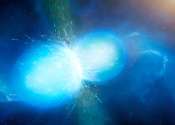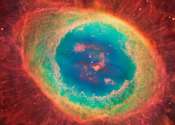Last update:
Astrobiology news

Study shedding new light on Earth's global carbon cycle could help assess liveability of other planets
Research has uncovered important new insights into the evolution of oxygen, carbon, and other vital elements over the entire history of Earth—and it could help assess which other planets can develop life, ranging from plants ...
Astrobiology
Apr 10, 2024
0
83

Measuring the atmospheres of other worlds to see if there are enough nutrients for life
Life on Earth depends on six critical elements: carbon, hydrogen, nitrogen, oxygen, phosphorous, and sulfur. These elements are referred to as CHNOPS, and along with several trace micronutrients and liquid water, they're ...
Astrobiology
Apr 9, 2024
0
40

If life exists on Jupiter's moon Europa, scientists might soon be able to detect it
Europa is one of the largest of more than 90 moons in orbit around the planet Jupiter. It is also one of the best places to look for alien life.
Astrobiology
Apr 6, 2024
1
211

Why there may be oceans inside dwarf planets beyond Pluto—and what this means for the likely abundance of life
Earth was long thought to be the only planet in our solar system with an ocean, but it is beginning to look as though there are underground oceans inside even the most surprising icy bodies.
Astrobiology
Apr 4, 2024
0
50

Is the universe really a 'dark forest' full of hostile aliens in hiding?
We have no good reason to believe that aliens have ever contacted Earth. Sure, there are conspiracy theories and some rather strange reports about harm to cattle, but nothing credible. Physicist Enrico Fermi found this odd. ...
Space Exploration
Apr 4, 2024
4
80

Meteorites: Why study them? What can they teach us about finding life beyond Earth?
Universe Today has explored the importance of studying impact craters, planetary surfaces, exoplanets, astrobiology, solar physics, comets, planetary atmospheres, planetary geophysics, and cosmochemistry, and how this myriad ...
Astrobiology
Apr 1, 2024
0
10

Gravitational waves may have made human life possible
Could it be that human existence depends on gravitational waves? Some key elements in our biological makeup may come from astrophysical events that occur because gravitational waves exist, a research team headed by John R. ...

Cosmochemistry: Why study it? What can it teach us about finding life beyond Earth?
Universe Today has had some fantastic discussions with researchers on the importance of studying impact craters, planetary surfaces, exoplanets, astrobiology, solar physics, comets, planetary atmospheres, and planetary geophysics, ...
Astrobiology
Mar 28, 2024
0
33

Life might be difficult to find on a single planet but may be obvious across many worlds
If we could detect a clear, unambiguous biosignature on just one of the thousands of exoplanets we know of, it would be a huge, game-changing moment for humanity. But it's extremely difficult. We simply aren't in a place ...
Astrobiology
Mar 27, 2024
0
39

The mystery of fullerenes in space explained
A study from the Instituto de Astrofísica de Canarias (IAC) which combines laboratory chemistry with astrophysics, has shown for the first time that grains of dust formed by carbon and hydrogen in a highly disordered state, ...
Astronomy
Mar 27, 2024
0
269

New NASA software simulates science missions for observing terrestrial freshwater
From radar instruments smaller than a shoebox to radiometers the size of a milk carton, there are more tools available to scientists today for observing complex Earth systems than ever before. But this abundance of available ...
Space Exploration
Mar 26, 2024
0
7

Signs of life detectable in single ice grain emitted from extraterrestrial moons, experimental setup shows
The ice-encrusted oceans of some of the moons orbiting Saturn and Jupiter are leading candidates in the search for extraterrestrial life. A new lab-based study led by the University of Washington in Seattle and the Freie ...
Astrobiology
Mar 22, 2024
1
2420

Life's building blocks are surprisingly stable in Venus-like conditions: Study
If there is life in the solar system beyond Earth, it might be found in the clouds of Venus. In contrast to the planet's blisteringly inhospitable surface, Venus' cloud layer, which extends from 30 to 40 miles above the surface, ...
Astrobiology
Mar 20, 2024
1
204

Planetary geophysics: What is it? What can it teach us about finding life beyond Earth?
Universe Today has examined the importance of studying impact craters, planetary surfaces, exoplanets, astrobiology, solar physics, comets, and planetary atmospheres, and how these intriguing scientific disciplines can help ...
Astrobiology
Mar 19, 2024
0
1

Could Earth life survive on a red dwarf planet?
Even though exoplanet science has advanced significantly in the last decade or two, we're still in an unfortunate situation. Scientists can only make educated guesses about which exoplanets may be habitable. Even the closest ...
Astrobiology
Mar 18, 2024
0
19

Protein fragments ID two new 'extremophile' microbes—and may help find alien life
Perfectly adapted microorganisms live in extreme environments, from deep-sea trenches to mountaintops. Learning more about how these extremophiles survive in hostile conditions could inform scientists about life on Earth ...
Astrobiology
Mar 15, 2024
0
76

Unraveling the origins of life: Scientists discover 'cool' sugar acid formation in space
A critical molecule for the metabolism of living organisms has been synthesized for the first time by University of Hawaiʻi at Mānoa researchers at low temperatures (10 K) on ice coated nanoparticles mimicking conditions ...
Astrobiology
Mar 13, 2024
1
180

The LIFE telescope passed its first test, detecting biosignatures on Earth
We know that there are thousands of exoplanets out there, with many millions more waiting to be discovered. But the vast majority of exoplanets are simply uninhabitable. For the few that may be habitable, we can only determine ...
Astrobiology
Mar 12, 2024
0
41

NASA's search for life on Mars: A rocky road for rovers, a long slog for scientists, and a battle of the budget
Is or was there life on Mars? That profound question is so complex that it will not be fully answered by the two NASA rovers now exploring it.
Astrobiology
Mar 12, 2024
0
16

NASA unveils design for message heading to Jupiter's moon Europa
When it launches in October, the agency's Europa Clipper spacecraft will carry a richly layered dispatch that includes more than 2.6 million names submitted by the public.
Space Exploration
Mar 8, 2024
2
279
More news

Study finds the West is best to spot UFOs

Could tardigrades have colonized the moon?

Subglacial microbial life on Earth and beyond

Saturn's largest moon most likely uninhabitable

Did the Galileo mission find life on Earth?
Other news

Climate-change-driven cold snaps threaten marine life

L-cyclodextrins synthesized in the lab for the first time

Attosecond imaging made possible by short and powerful laser pulses

Spiraling insights: Scientists observe mechanical waves in bacterial communities

A single atom layer of gold—researchers create goldene

NASA is seeking a faster, cheaper way to bring Mars samples to Earth

The improbable origins of life on Earth

Exploring the galactic habitable zone

Why European colonization drove the blue antelope to extinction

Study uses thermodynamics to describe expansion of the universe

Internet can achieve quantum speed with light saved as sound

Researchers discover new clues to how tardigrades can survive intense radiation




















































